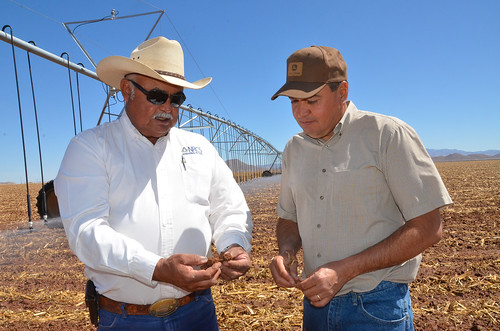
Travel 30 miles south of Alfredo and Sabrina Zamora’s farm in Cochise County, Ariz., and the imposing border fence between the U.S. and Mexico rises up across the horizon. This border county is rural, arid, open land where the Zamoras have spent their lives farming.
The couple is well known in the area for their cotton, pecans and alfalfa crops and they are no strangers at the local USDA Natural Resources Conservation Service office in Douglas. They’ve worked with NRCS over the years to plan out and implement conservation on their farm, including more efficient water and irrigation practices, the use of crop residue to improve soil health and the reduction of soil erosion.
Both Zamoras grew up in Cochise County, and from a young age, they were in the fields working for area farmers. They left to attend college, but returned home after graduation in the 1990s to farm their own land. Almost immediately, Alfredo consulted with NRCS about available assistance.
“It was very hard for somebody like me with very little experience and no money to go into a government office and ask for things. We’ve come a long way in the last 20 years; I’d say in that I feel completely comfortable going in there,” Alfredo says.
Recently, the Zamoras replaced four outdated pivot irrigation systems with new upgraded ones on their cropland with help from the USDA StrikeForce Rural Growth and Opportunity initiative. The new pivot irrigation lines are 10 percent more efficient in water use and electricity and should last up to 30 years, ultimately saving not just water, but also money.
The national initiative addresses high-priority funding and technical assistance needs in rural communities in 16 states, including Arizona, with a special emphasis on historically underserved communities and areas with persistent poverty.
Gerry Gonzalez, district conservationist with the NRCS in Douglas, was excited when he learned that Arizona was part of StrikeForce, because the initiative provides NRCS additional funding to do specialized outreach to historically underserved communities.
“Here along the border areas, there are a lot of small landowners—a lot of underserved, nontraditional clients and the USDA Strikeforce initiative provides opportunities for them,” Gonzalez says.
The Zamoras have worked closely over the years with Gonzalez and agree with him that the initiative provides an opportunity for people interested in farming to possibly reach that goal.
The Zamoras serve as an example of how NRCS can help make a difference on their operation. They regularly hold field days on their farm to share with other local farmers the benefits of USDA programs and to increase participation in those programs, especially among Hispanic farmers, who USDA considers a historically underserved population.
Follow NRCS on Twitter.
Check out other conservation-related stories on the USDA blog.

